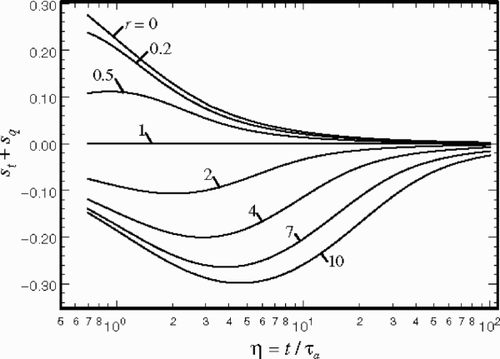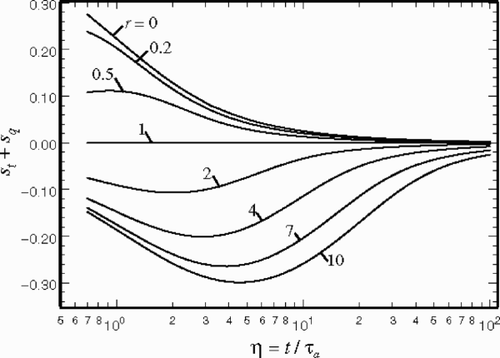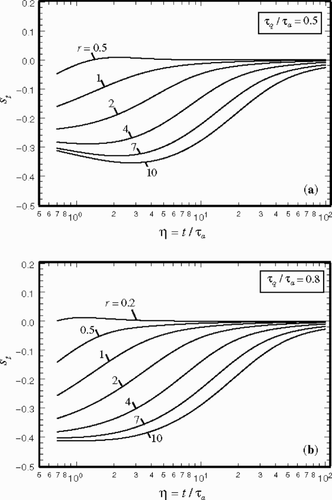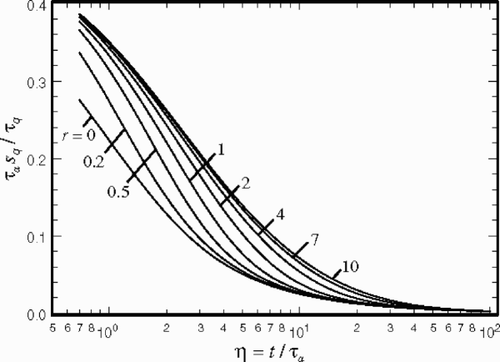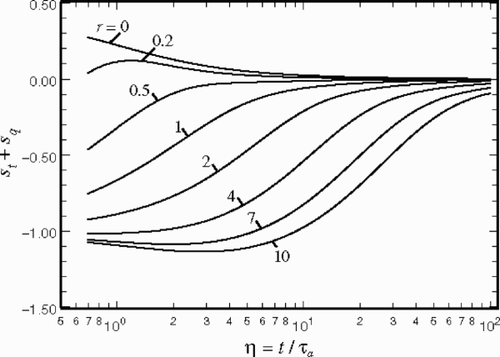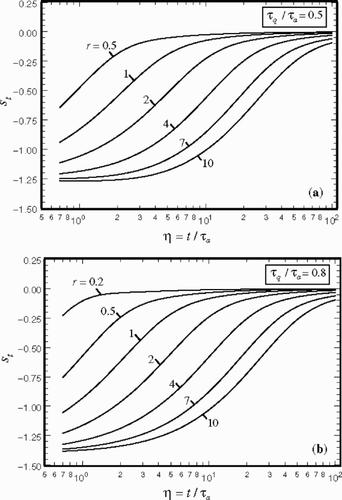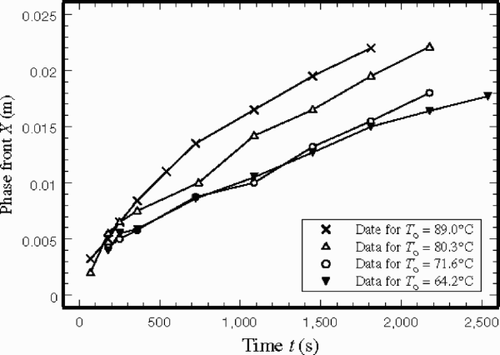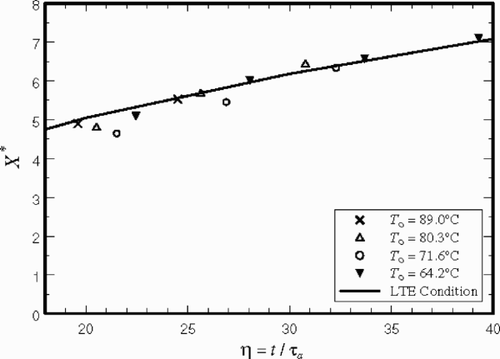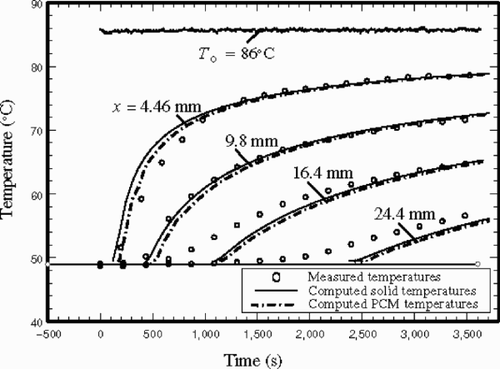Abstract
The sensitivity coefficients for analyzing the interstitial properties during phase change in porous media are presented. Computation of the sensitivity coefficients and estimation of parameters are the main objective of this study. Experimentally measured temperature data provide an estimate of the phase front locations used as the state variable for this study. The derivations are based on the assumption that the phase front, X, at a given time, t, is a function of interstitial properties τt and τq with all other parameters remaining constant. The properties τt and τq are the lag-time in temperature and heat flux, respectively. The study of the sensitivity coefficients using these two parameters is the objective of this study. The analysis includes two types of boundary conditions of the first kind: prescribed temperature of phase change materials and prescribed temperature for solid matrix. These boundary conditions are related to the conditions under which the experimental data used in this article were collected. The results confirm the existence of the local thermal non-equilibrium condition at the onset of a phase change phenomenon.
1. Introduction
Mathematical models are often formulated to describe and elucidate the behavior of an engineering system, and also to illustrate quantitatively available experimental data. These models are often represented in the form of a complex, multi-parameter partial differential equation. In most cases, the correlation between the parameters and the state variables are not known a priori. This information is needed to gain understanding of the response of the state variable to alteration in the parameters. The partial derivative of the state variable with respect to the parameters is referred to as the sensitivity coefficient. Sensitivity coefficients are very useful in parameter estimation Citation[1,Citation2], optimal experimental design Citation[3,Citation4], and uncertainty or error analysis Citation[5,Citation6]. The determination of the sensitivity coefficient for analyzing interstitial properties during phase change in porous media is the subject of this investigation.
Phase change phenomena in porous media are often encountered in numerous science and engineering applications. These include melting and freezing of biological tissue, freezing of soil, food preservation, and formation of metal matrix composites by infiltration of molten metals into fibrous preforms of composite Citation[7,Citation8]. In a theoretical study of phase change phenomena in porous media, Harris et al. Citation[9] derived the governing equations for non-Fourier heat conduction in porous media. This derivation leads to the emergence of two key thermal parameters: lag time in temperature τt, due to interstitial heat transfer coefficient, and lag time in heat flux τq due to contact/constriction resistance. Direct measurement of the lag times is impractical and presents a formidable experimental task. Under local thermal non-equilibrium (LTNE) condition, the values of these parameters (τt and τq) are required for analytical or numerical prediction of the state variables (rate of heat transfer, temperature distribution, and phase front location) during rapid phase change process in porous media. In addition, knowledge of the sensitivity of the state variables τt and τq is essential to determine the extent and existence of the LTNE condition. The measured location of the phase front can provide an estimate of these interesting parameters using an inverse methodology. In an experimental investigation of phase change phenomena in porous media, Nnanna et al. Citation[7,Citation8] predicted the variation of the phase front location as a function of time using experimentally measured temperature data. This experimental study utilizes the theoretical information in Citation[9,Citation10]. The results in Citation[8] clearly show that, early during the phase change process, the Sparrow number Citation[10], defined as (---595----1) , is relatively small indicating that the solid matrix is not at the local thermal equilibrium with the pore materials. At larger time, the Sparrow number increases rapidly and the system approaches the local thermal equilibrium condition. The measured temperature and phase front data by Nnanna et al. Citation[8] will be used as the state variables for the sensitivity analysis and parameter estimation in this study.
The problem under consideration is a porous medium whose pores are occupied by the phase change material; and the porous media is subjected to the prescribed constant temperature condition at x = 0 surface and time t ≥ 0. The computation of the sensitivity coefficients followed by an inverse methodology to evaluate a theoretical model in Citation[9] is the main objective of this study. Knowledge of the sensitivity coefficients is essential when using inverse methodologies to estimate the thermophysical properties Citation[11–Citation18]. The derivations of the sensitivity coefficients are based on the assumption that the phase front, X, at a given time, t, is a function of τt and τq with all the other parameters remaining constant. The analysis includes two types of boundary conditions: prescribed temperature of phase change materials and prescribed temperature for solid matrix. The boundary condition at x = 0 dictates the type of solution for the temperature field and phase front. The mathematically simplest method is to consider the liquid phase, at x = 0 surface, to assume a prescribed constant temperature at time t ≥ 0; this will be designated as Case 1. The second and more realistic case is for the matrix, at x = 0 surface, to have a prescribed constant temperature at time t ≥ 0, Case 2.
2. Non-Fourier heat conduction in porous media
Amiri and Vafai Citation[19,Citation20] used a two-equation model to study energy transport in porous media in the absence of local thermal equilibrium. Minkowycz et al. Citation[10] used the relations in Citation[19,Citation20] to introduce the following governing equations for non-Fourier heat conduction in porous media; they are
(---595--1)
and the pore mean temperature Tp is related to the solid matrix temperature Ts by the relation Citation[10]
(---595--2)
where τt represents a time delay parameter related to the thermal capacitance of the materials in the pores, τq is another time delay that describes the effect of constriction/contact resistance, τe = Csτt/C, τa = τe + τq, and
(---595----2) . Harris et al. Citation[9] developed the same relations by modifying equations in Citation[19,Citation20] to account for the effect of the thermal capacitance of the materials during the phase change process. Because the transport of energy during the phase change process is very slow, continuum analysis can be used to estimate these interstitial parameters. It is to be noted that similar relations evolve when using a continuum approach to study heat transfer in rapid laser heating Citation[21]; however, the role of the interstitial parameters is different. A discussion of the similarities between the energy equations in porous media and in microstructures is presented in Citation[21].
When the surface temperature is prescribed Ts = T0 and the material is initially at a constant phase-change temperature Tm, using a dimensionless temperature θp = (Tp − Tm)/(T0 − Tm), the Laplace transform θp is
(---595--3)
where s is the Laplace transform variable, Lp is the Laplace operator,
(---595----3) . In the derivation of Equationequation (3)
(---595--3) it is necessary to have
(---595----4) at ξ = 0. The Laplace transform Equationequation (3)
(---595--3) provides the condition
(---595----5) . In practice, it is possible to obtain the inverse Laplace transform of Equationequation (3)
(---595--3) numerically. Moreover, Equationequation (2)
(---595--2) yields the dimensionless temperature of the solid matrix also in the Laplace transform space as
(---595--4)
In a one-dimensional theoretical study of melting or freezing within a plane wall, Harris et al. Citation[9] assumed that the LTNE condition exists at and behind the phase front. An analytical or numerical solution requires knowledge of the effect of the interstitial heat transfer coefficient and constriction/contact resistance within the solid matrix. The measured location of the phase front can provide an estimate of these interesting parameters using an inverse methodology. The boundary conditions at x = 0 dictate the type of solution for the temperature field and phase front. The mathematically simplest method is to consider the liquid phase, at x = 0 surface, to assume a prescribed constant temperature at time t ≥ 0; this will be designated as Case 1. The second and more realistic case is for the matrix, at x = 0 surface, to have a prescribed constant temperature at time t ≥ 0, Case 2.
3. Sensitivity coefficients for parameter estimation
Knowledge of sensitivity coefficients is essential when estimating parameters Citation[2]. The sensitivity coefficients for the two cases mentioned earlier is given emphasis in this section.
3.1. Case 1
This case has the simplest type of solution and it assumes the materials in the pore arrive at a fixed temperature; that is Tp(0, t) = T0. Assuming the phase change materials consume the entire wall heat flux, this yields the theoretical location of the front Citation[9] as
(---595--5)
where
(---595--6)
and
(---595--7)
The sensitivity coefficients for predicting τt and τq are
(---595----6) and
(---595----7) . The computation of the sensitivity coefficients is the main objective of this study. As a shorthand notation, one can set
(---595----8) , then equation
(---595----9) relates the dimensionless phase front X* to the phase front X. Therefore, the parameter X* depends on the independent variables
(---595--8)
where C is the equivalent capacitance and Cs is the capacitance of the solid matrix. Next, the sensitivity coefficients are obtainable, using differentiation by parts, from the relations
(---595--9-)
and
(---595--9-)
It is assumed that both C and Cs are constants and therefore
(---595--10-)
and
(---595--10-)
The next task is to relate derivatives ∂X/∂r and ∂X/∂τa in Equationequations (9a)
(---595--9-) and Equation(9b)
(---595--9-) to X* and its derivatives; they are:
(---595--11-)
(---595--11-)
Using Equationequation (5)
(---595--5) , and appropriate differentiations lead to the computation of sensitivity coefficients. For this purpose, it is appropriate to use integration by parts and write Equationequation (5)
(---595--5) in the following form
(---595--12)
Then, the derivatives of the dimensionless phase front X* with respect to r and η become
(---595--13)
and
(---595--14-)
EquationEquation (14a)
(---595--14-) , using integration by parts, takes the following form
(---595--14-)
In dimensionless space, the dimensionless sensitivity coefficients as defined in Equationequations (9a)
(---595--9-) and Equation(9b)
(---595--9-) are
(---595--15-)
and
(---595--15-)
Then, using Equationequations (9a
(---595--9-) –Equationb)
(---595--9-) and Equation(10a
(---595--10-) –Equationb)
(---595--10-) , they take the following forms,
(---595--16-)
and
(---595--16-)
According to Equationequations (11a)
(---595--11-) and Equation(11b)
(---595--11-) , the following quantities
(---595--17-)
and
(---595--17-)
are obtainable since ∂X*/∂r and ∂X*/∂η are obtainable using Equationequations (13)
(---595--13) and Equation(14b)
(---595--11-) . Next, they are to be substituted in Equationequations (16a)
(---595--16-) and Equation(16b)
(---595--16-) in order to obtain the sensitivity coefficients as
(---595--18-)
and
(---595--18-)
The aforementioned derivations of the sensitivity coefficients are based on the assumption that the phase front X at a given time t is a function of τt and τq with all the other parameters remaining constant. All the sensitivity coefficients are computed with a high degree of accuracy using Mathematica. shows the variation of τasq/τq within Equationequation (18b)(---595--18-) as a function of r and η; that is,
(---595--19)
This will facilitate the prediction of sq for all values of τq and τa = τq + τtCs/C. In addition, Equationequation (18a)
(---595--18-) reduces to
(---595--20)
shows the variation of the function st + sq as a function of η and r. This scheme permits a graphical presentation of τt and τq without using τq/τa as a secondary variable.
shows the sensitivity coefficient sq > 0 over the entire range of the variables η and r. Moreover, sq has a relatively larger value when η<10 and τq is finite. indicates that st + sq is negative when r > 1; therefore, the magnitude of |st | exceeds the values of |st + sq | plotted in since sq > 0. also reveals that st + sq = 0 when r = 1. This information is significant because the variables st and sq have the same magnitude with opposite signs. This implies that these two sensitivity coefficients become linearly dependent and it will be difficult to predict both values τt and τq in the neighborhood of r ≈ 1. The analysis shows that the magnitude of st becomes small as r reduces from below 1.
When τq/τa is finite, according to Equationequation (8)(---595--8) , it is possible to write
(---595--21-)
that reduces to
(---595--21-)
The equality in this relation serves as a limit since C includes the effect of latent heat and it is generally larger than Cs. To further elaborate on this issue, the value of st vanishes when τt = 0 and therefore τq/τa = 1. Therefore, having Cs ≠ 0, the coefficient τq/τa = 1 implies r = 0. When the τt value is small but finite, the parameter τq/τa will have a near unit value.
shows the variation of st when τq/τa = 0.5 and τq/τa = 0.8. This figure shows that the st values are small when the parameter r is small. According to Equationequation (21b)(---595--21-) , τq/τa = 0.8, the lowest limiting value for r is 0.2 while when τq/τa = 0.5, the lower limit is r = 0.5. Moreover, according to Equationequation (18b)
(---595--18-) , as τq → 0, then sq = 0 and then directly provides the values of st.
3.2. Case 2
This case assumes that the solid matrix arrives at a fixed temperature; that is Ts (0, t) = T0. This yields the following theoretical location of the phase front as
(---595--22)
Equation (Citation22) has a form similar to that of Equationequation (12)
(---595--12) except for two modifications: the first modification replaces the factor
(---595----10) by
(---595----11) and the second modification is the addition of τ and
(---595----12) within the integrand. Therefore, Equationequation (13)
(---595--13) is to be replaced by the following relation
(---595--23)
while Equationequations (14a)
(---595--14-) and Equation(14b)
(---595--14-) are to be replaced by
(---595--24)
that can be written as
(---595--25)
Finally, Equationequations (18)
(---595--18-) –Equation(20)
(---595--20) can provide the sensitivity coefficients when X* is taken from Equationequation (22)
(---595--22) , ∂X*/∂r from Equationequation (23)
(---595--23) , and ∂X*/∂η from Equationequation (24)
(---595--24) or Equation(25)
(---595--25) .
shows the variation of τasq/τq for Case 2 using Equationequation (19)(---595--19) . The behavior of the sensitivity coefficient sq is similar to that for ; however, its magnitude is larger. The values of sensitivity data when r = 0 remain the same for the data in both and and there is a larger dispersion when r varies between 0 and 1. The values of st + sq for this case are plotted in . Again the graph shows a slight increase in the values of st + sq in comparison to the data plotted in . A significant difference is that the data in , when r = 1, are finite. This is in contrast to those in where st + sq = 0. There are theoretical reasons for this phenomenon. In general, when r = τt/τe = 1, Equationequation (1)
(---595--1) can be written as
(---595---1)
Therefore, a solution based on the assumption of local thermal equilibrium (LTE) also satisfies this equation. For Case 1, the values of Tp were prescribed at x = 0 and at t = 0; therefore, the final solution became independent of τt and τq. However, for Case 2, the temperature of the solid matrix Ts was specified at x = 0; therefore, an examination of Equationequation (2)
(---595--2) shows that the temperature Tp would depend on τt. demonstrates the behavior of st for two values of τq/τa = 0.5 and 0.8. The data indicate a similar trend to those in but st values have larger magnitudes.
4. Parameter estimation using experimental data
4.1. Experimental data
The experimental data utilized in this estimation consists of the measurement of the phase front during the melting of 99% pure tetracosane within a bed of randomly packed 3-mm diameter solid glass spheres. The commercially available glass spheres have desirable thermophysical properties and they are opaque to thermal radiation with wavelengths larger than 5 µm. The porosity of this porous medium is 0.446. The tetracosane has a melting temperature of 49.5°C. The density is 796 kg m−3 at and near the melting temperature and the latent heat of fusion is 255 kJ kg−1. The other thermophysical properties of tetracosane are: the thermal conductivity of liquid phase is 0.17 W m K−1, and the thermal conductivity of solid phase is 0.24 W m K−1, both at and near the melting temperature. Using a guarded hot plate technique and steady state condition, Nnanna Citation[7] measured the equivalent thermal conductivity of the PCM-saturated porous medium to be 0.55 W m K−1. The measured locations of the phase front as a function of time are shown in . The graph includes four sets of data, each for a different surface temperature, T0 = 89.0, 80.3, 71.6, and 64.2°C.
4.2. Parameter estimation
Case 2 relates to the experimental data gathered in this study. There are three parameters to be estimated, L, τt, and τq. It is possible to determine the average value of the effective latent heat of fusion L that includes the effects of porosity and the influence of the mushy zone. A direct estimation of L is possible by examining the variation of the phase front at larger values of time when the assumption of LTE is valid. Under LTE condition Citation[9], the following relation applies,
(---595---2)
According to this relation, each set of (t, X) data in provides a value for L and the computed mean value is L = 208.9 kJ kg−1. Once the value of L is known, the effective heat capacitance
(---595----13) is readily available and it would depend on the surface temperature T0 while the heat capacitance of the solid matrix is a constant, Cs = 1583 kJ m−3.
The final task is the determination of optimum values for τt, and τq using the data in . The method of estimation, discussed below, requires initial estimations for τt, and τq. The relation (---595----14) Citation[10] yields an initial estimated value of τq ≈ 50 s. An initial estimation for the value of τt depends on the interstitial heat transfer coefficient h Citation[10]. For an initial estimation, τt ∼
(---595----15) when hrh /ke = 2/3 provides the interstitial heat transfer coefficient and Ts − Tm ≈ 4–5°C; this procedure yields a value of τt ≈ 60 s.
The basic estimation procedure is the method of choice Citation[2, section 7.4] for computing τt and τq. In the following presentation, τt,e is the initial value of τt and τq, e is the initial value of τq. Moreover, X m,i is the measured value of phase front X for the i-th data while values X c,i is its computed value obtained using τt, e and τq,e in Equationequation (22)(---595--22) . This leads to the following relations based on the Taylor series expansion Citation[3],
(---595--26)
where N is the number of data points, a1 = τ t /τ t, e − 1, and a2 = τq /τq, e − 1. Since st and sq are computed at a time at which X m, i is measured, this leads to a 2 × N matrix of the sensitivity coefficients and Equationequation (26)
(---595--26) takes the form
(---595--27)
that can be rewritten, in shorthand notation, as
(---595--28)
where S is the matrix of the sensitivity coefficients, A is the vector of unknowns (a1, and a2), and D is a vector that contains the deviations. The unknown coefficients a1, and a2, members of vector A, are obtainable from the relation
(---595--29)
Once the values of a1, and a2 are in hand, the following relations provide the new values for τt and τq,
(---595--30-)
and
(---595--30-)
The computed values of τt and τq can serve as a new set of estimates. An iterative procedure produced τt = 60.1 s, and τq = 47.3 s due to the combined effects of the surface temperature values in . These quantities resulted in a standard deviation in the estimated value of X equal to ∼0.00075 m. By definition, the standard deviation (SD) is
(---595---3)
and it is plotted in to demonstrate the behavior of SD as each τt or τq deviates from the computed minimum of 0.0007474 m. indicates that both lines have the same minimum and the changes in the computed value of SD is small as τq changes. In contrast, a small change in τt results in an appreciable change in SD.
Figure 8. Variation of the standard deviation at and near its estimated optimum value of SD = 0.0007474 m as τt or τq changes.
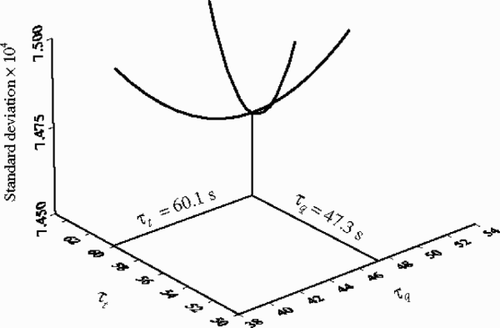
Following the determination of τt and τq, it is appropriate to demonstrate a comparison between the computed and measured values of X*. Although the data in show significant uncertainties, the estimated phase front in agree reasonably well with the measured values. shows larger differences while a slightly improved accuracy in the estimated values is detectable in . Moreover, shows the values of X* computed under near LTE condition when L = 208.9 kJ kg−1. contains the data in – at larger values of time η, as they approach the LTE condition. There is a reasonably good agreement between the asymptotic behavior of the discrete data and the theoretical solid line obtained assuming LTE condition; this attests to the accuracy of the estimated value of L.
Figure 9. A comparison of the measured and estimated values of dimensionless phase front when (a) T0 = 89.0°C, (b)T0 = 80.3°C, (c) T0 = 71.6°C, and (d) T0 = 64.2°C.
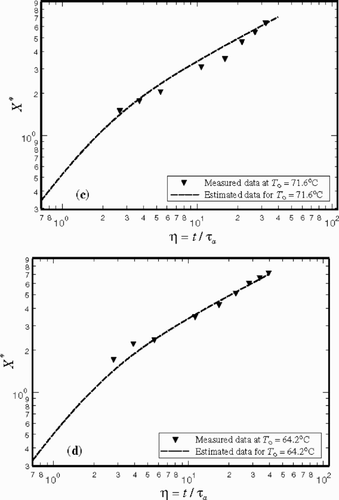
In the derivation of Equationequation (5)(---595--5) , it is hypothesized that after initiation of the phase change process all the thermal energy entering the wall will be consumed during the phase change process; therefore, the heat flux is approximated to be independent of position at any time t. Certainly, this assumption introduces errors at two occasions: first, at the beginning of the process, since there is a rapid change in temperature near the boundary before the onset of and during the phase change process. Second, later in the process, there will be a departure from the theory because a measurable but small Ts − Tm does not produce sufficient melting and this causes a mushy zone to form and advance ahead of the phase front. However, these effects do appear if the local temperature is computed as a function of time. Based on the assumption of quasi-constant wall heat flux,
(---595--31-)
This approximation suggests that the solid phase temperature is a linear function of x; therefore, one can write
(---595--31-)
and the corresponding dimensionless temperature as
(---595--31-)
Accordingly, the value of θs(x, t) is readily available as the value of X(t) was defined earlier. Since
(---595----16) , the relation
(---595--32)
yields the value of θp(ξ, η) and subsequently the mean temperature of materials in the pores Tp(x, t).
As an illustration, this procedure was employed to compute the values of Tp(x, t) using Equationequation (3)(---595--3) and Ts(x, t) using Equationequation (4)
(---595--4) . The inverse Laplace transforms were obtained numerically by a special Mathematica Citation[22] inversion package Citation[23]. In addition, the analysis includes an estimated contact resistance of 0.0055 m2 K W−1 between Ts(0, t) and the wall. For the purpose of investigating the expected accuracy, the computed temperature is compared with an alternative set of data, different from those used in the earlier analysis. This set of data is plotted at four different locations, using discrete symbols, in . The data are for the initial temperature of 49°C and a wall temperature of ∼86°C. There is a remarkably good agreement with the recorded temperature at x = 9.8 mm. At a location closer to the wall, the experimental data show lower values at small values of time. This is due to the first uncertainty case, discussed earlier, because the analysis ignores the capacitance of the porous materials. This situation is reversed at the locations further away from the surface, as the experimental data have higher values at smaller relative time. This implies that the mushy zone may have extended to beyond the theoretical prediction of the location of the phase front. According to data plotted in , the temperature deviation is ±4°C indicating a reasonable error of ±11% in the computed values of heat flux from the wall. This error is consistent with the deviations detectable in and in the estimation of the location of the phase front.
5. Conclusion
Results for the first case show that for any given ratio τt/τq, the sensitivity coefficient decreases asymptotically to zero at large times. Furthermore, the sum of the sensitivity coefficients is st + sq = 0 when τt/τq ≈ 1. This information is significant because the variables st and sq have the same magnitude with opposite signs. This implies that these two sensitivity coefficients become linearly dependent and it will be difficult to predict the values of τt and τq in the neighborhood of τt/τq ≈ 1. A similar trend but with different sensitivity values is reported for the second case.
This study reveals that the problem of rapid melting/freezing of a porous material differs from that under LTE condition. The procedure employed is an effective method to study the local thermal non-equilibrium behavior of phase change materials. The earlier data show that during the melting of materials in a cell, there is a measurable temperature difference, Ts − Tp, that can exceed 4°C. This difference gradually disappears upon termination of the phase change process. In general, this study shows that the theoretical model in Citation[9] adequately predicts the location of the phase front. However, the temperature predictions are accurate when the mushy zone is small. shows that the agreement between predicted and measured local temperature improves following the completion of melting and disappearance of the mushy zone.
Nomenclature
Table
Greek symbols
Table
Subscripts
- Dowding, KJ, Beck, JV, and Blackwell, BF, 1999. Estimating temperature-dependent thermal properties of carbon–carbon composite, Journal of Thermophysics and Heat Transfer 13 (3) (1999), pp. 328–336.
- Beck, JV, and Arnold, KJ, 1977. Parameter Estimation in Engineering and Science. New York. 1977.
- Taktak, R, Beck, JV, and Scott, E, 1993. Optimal experimental design of estimating thermal properties of composite materials, International Journal of Heat and Mass Transfer 36 (12) (1993), pp. 2977–2986.
- Emery, AF, and Fadale, TD, 1996. Design of experiments using uncertainty information, ASME Journal of Heat Transfer 118 (3) (1996), pp. 532–538.
- Fadale, TD, and Emery, AF, 1994. Transient effects of uncertainties on the sensitivities of temperature and heat fluxes using stochastic finite elements, ASME Journal of Heat Transfer 116 (4) (1994), pp. 808–814.
- Bieniasz, LK, and Speiser, B, 1998. Use of sensitivity analysis method in the modelling of electrochemical transients: Part 3. Statistical error/uncertainty propagation in simulation and in nonlinear least-squares parameter estimation, Journal of Electroanalytical Chemistry 458 (1–2) (1998), pp. 209–229.
- Agwu Nnanna, AG, 2002. "Phase change phenomena in porous media: a local thermal non-equilibrium study". In: PhD dissertation, The University of Texas at Arlington. Arlington, TX. 2002.
- Agwu Nnanna, AG, Haji-Sheikh, A, and Harris, KT, 2004. Experimental study of local thermal non-equilibrium phenomena during phase change in porous media, International Journal of Heat and Mass Transfer 47 (19–29) (2004), pp. 4365–4375.
- Harris, KT, Haji-Sheikh, A, and Nnanna, AGAgwu, 2001. Phase change phenomena in porous media – a non-local thermal equilibrium model, International Journal of Heat and Mass Transfer 44 (8) (2001), pp. 1619–1625.
- Minkowycz, WJ, Haji-Sheikh, A, and Vafai, K, 1999. On departure from local thermal equilibrium in porous media due to a rapidly changing heat source: the Sparrow number, International Journal of Heat and Mass Transfer 42 (18) (1999), pp. 3373–3385.
- Kim, SK, Jung, BS, Kim, HJ, and Lee, WI, 2003. Inverse estimation of thermophysical properties for anisotropic composite, Experimental Thermal and Fluid Science 27 (6) (2003), pp. 697–704.
- Dowding, KJ, Beck, JV, and Blackwell, BF, 1996. Estimation of directional-dependent thermal properties in a carbon–carbon composite, International Journal of Heat and Mass Transfer 39 (15) (1996), pp. 3157–3164.
- Fang, S, Gertner, GZ, and Anderson, AA, 2004. Estimation of sensitivity coefficients of nonlinear model input parameters which have a multinormal distribution, Computer Physics Communications 154 (1) (2004), pp. 9–16.
- Beck, JV, Blackwell, B, and Haji-Sheikh, A, 1996. Comparison of some inverse heat conduction methods using experimental data, International Journal of Heat and Mass Transfer 39 (17) (1996), pp. 3649–3657.
- Wen, X-H, Deutsch, CV, and Cullick, AS, 2003. Inversion of dynamic production data for permeability: fast streamline-based computation of sensitivity coefficients of fractional flow rate, Journal of Hydrology 281 (4) (2003), pp. 296–312.
- Ghojel, H, 2004. Experimental and analytical technique for estimating interface thermal conductance in composite structural elements under simulated fire conditions, Experimental Thermal and Fluid Science 28 (4) (2004), pp. 347–354.
- Aviles-Ramos, C, Haji-Sheikh, A, Beck, JV, and Dowding, KJ, 2001. Estimation of thermophysical properties by the spectral method – development and evaluation, ASME Journal of Heat Transfer 123 (1) (2001), pp. 24–30.
- Dowding, KJ, and Blackwell, BF, 2001. Sensitivity analysis of nonlinear heat conduction, ASME J. Heat Transfer 123 (1) (2001), pp. 1–10.
- Amiri, A, and Vafai, K, 1994. Analysis of dispersion effects and non-thermal equilibrium, non-Darcian, variable porosity incompressible flow through porous media, International Journal of Heat and Mass Transfer 37 (6) (1994), pp. 939–954.
- Amiri, A, and Vafai, K, 1998. Transient analysis of incompressible flow through a packed bed, International Journal of Heat and Mass Transfer 41 (24) (1998), pp. 4259–4279.
- Tzou, DK, 1997. Macro- to Microscale Heat Transfer. New York. 1997.
- Wolfram, S, 1999. The Mathematica Book. Cambridge, UK. 1999, 4th Edn.
- Valkó, PP, and Abate, J, 2004. Comparison of sequence accelerators for the Gaver method of numerical Laplace Transform Inversion, Computers & Mathematics with Applications 48 (2004), pp. 629–636.
